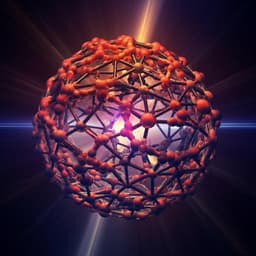
Physics
Unconventional anomalous Hall effect and large anomalous Nernst effect in antiferromagnet SmMnBi₂
K. Tang, Y. Yang, et al.
Discover the groundbreaking research on the unconventional anomalous Hall effect and the large anomalous Nernst effect in the antiferromagnetic material SmMnBi₂, conducted by Kaixin Tang and colleagues. This study uncovers how Berry curvature plays a pivotal role in these phenomena, making SmMnBi₂ a fascinating candidate for studying unusual transverse transport effects.
~3 min • Beginner • English
Introduction
Anomalous transverse transport—electrical (AHE), thermoelectric (ANE), and thermal (anomalous Righi-Leduc effect)—occurs without Lorentz-force origin. In ferromagnets, anomalous coefficients scale with magnetization and can have intrinsic (Berry curvature) and extrinsic (scattering) origins enabled by spin–orbit coupling (SOC) and broken time-reversal symmetry. In collinear antiferromagnets, combined symmetries often nullify net Berry curvature, suppressing intrinsic anomalous responses. However, large AHE/ANE have recently been found in antiferromagnets with noncollinear/noncoplanar spin textures and nontrivial band topology (e.g., Mn₃Sn, Mn₃Ge, YbMnBi₂, YMn₆Sn₆, CoNb₃S₆). Antiferromagnets offer minimal stray fields and can exhibit AHE/ANE not proportional to magnetization, unlike most ferromagnets. Proposed origins include real-space Berry curvature from chiral spin textures, field-tuning of Weyl nodes and anticrossings, SOC with special symmetries, and domain-wall effects. The RMnPn₂ (R: rare-earth/alkaline-earth; Pn: Sb/Bi) family hosts Dirac/Weyl semimetal states intertwined with AFM order. SmMnBi₂ is unique within this family: it is tetragonal (I4/mmm) with MnBi₂ square-planar coordination, implying a more complex electronic structure. This study investigates whether SmMnBi₂ hosts UAHE and large ANE, and clarifies their microscopic origins.
Literature Review
Prior studies established intrinsic and extrinsic mechanisms for AHE/ANE in ferromagnets and highlighted symmetry constraints in collinear antiferromagnets. Large anomalous transport in noncollinear AFMs (Mn₃Sn, Mn₃Ge) and RMnPn₂ members (e.g., YbMnBi₂) has been linked to Berry curvature from Weyl nodes, gapped Dirac crossings, and spin chirality. In YbMnBi₂, small Mn-spin canting in a C-type AFM lifts band degeneracy to yield a Weyl state with large AHE/ANE. Comparatively, SmMnBi₂ differs structurally (tetragonal, square-planar MnBi₂ coordination), motivating exploration of its band topology and anomalous transport. The literature also proposes field-tuning of Weyl nodes via exchange splitting in magnetic topological materials and extrinsic skew-scattering contributions to anomalous thermoelectric responses.
Methodology
- Crystal growth: SmMnBi₂ single crystals synthesized by Bi self-flux (Sm:Mnb:Bi = 1:1:10) in evacuated quartz; heated to 1100 °C (12 h), slow-cooled to 500 °C over 7 days; flux removed by centrifugation. Stoichiometry verified by FESEM/EDX.
- Structure: Single-crystal XRD (SmartLab-9, Cu Kα₁) and four-circle goniometer analysis confirmed tetragonal I4/mmm, a=b=4.506 Å, c=20.597 Å, and layer stacking; noted MnBi₂ square-planar coordination.
- Magnetism: Magnetic susceptibility and isothermal M(H) measured in MPMS3 with H∥c and H⊥c; identified AFM transition TN≈235 K; EPR determined Sm valence +2 (nonmagnetic), magnetism from Mn²⁺.
- Thermodynamic: Specific heat (PPMS-9T) to detect magnetic transition.
- Electrical transport: ρxx and ρxy measured simultaneously in a standard Hall bar (PPMS-9T). Contacts: Pt wires with Ag paste; ρxx symmetrized and ρxy antisymmetrized vs H; noise <0.01 μΩ cm. MR and Hall angle evaluated.
- Thermoelectric: Seebeck (Sxx) and Nernst (Sxy) via a home-built high-resolution thermoelectric puck in PPMS, AC differential thermocouple method; temperature gradient generated by chip resistor; type-E thermocouples; transverse voltages from Ag leads; Ag contribution subtracted using reference data. Primary geometry: ∇T in-plane, H∥c, voltage in-plane.
- Spectroscopy: ARPES at SSRF BL03U and SSRL, in situ cleave at 6.5 K, base pressure <5×10⁻¹⁰ Torr; linear horizontal/vertical polarizations; typical photon energy 82 eV; mapped FS and band dispersions along high-symmetry directions.
- Theory: DFT calculations (including SOC) with canted AFM configurations (C-type and G-type considered; in-plane FM component fixed along [100]); Berry curvature and anomalous Hall conductivity (AHC) tensors computed by Brillouin-zone integration; examined nodal features, symmetry constraints, and effect of spin canting angle on σxy.
Key Findings
- SmMnBi₂ is a metallic antiferromagnet with TN≈235 K (χ(T) irreversibility at 235 K; specific-heat anomaly). Magnetization and susceptibility indicate predominantly c-axis spins with small in-plane canting; polarized FM component per Mn ≈0.1–0.15 μB at 7 T.
- Transport: Metallic ρxx(T) with ρ0≈110 μΩ cm; Sxx<0 from 10–300 K, reaching ≈6 μV K⁻¹ at 300 K; MR and magnetothermopower behavior consistent with multiband, low mobility, poor compensation.
- Unconventional AHE: ρxy(H) shows a skewed, nonmonotonic peak at low fields shifting with T (μ0H≈0.06 T at 10 K to ≈1.3 T at 300 K), not tracking M(H) and inconsistent with ordinary Hall effect. σxy(H) exhibits a resonance-like low-field peak. Scaling analysis finds ρxy,max ∝ ρxx² up to T≈TN, with weakly T-dependent peak σxy, supporting intrinsic UAHE from Berry curvature. UAHE persists above TN with deviation from ρxy∝ρxx² scaling, indicating additional contributions.
- ANE: Sxy(H) mirrors ρxy(H) skewed peak with maximum amplitude ≈1.8 μV K⁻¹ (≈1.6 μV K⁻¹ at 300 K), large for an AFM metal, dominated by anomalous Nernst effect (arguments against normal Nernst provided). The ratio αxy/σxy exceeds the empirical kB/e≈86 μV K⁻¹ over broad T and H, suggesting significant extrinsic amplification (e.g., skew scattering), unlike several kagome/topological ferromagnets where the ratio approaches kB/e.
- ARPES/DFT: FS shows diamond-like contours and electron pockets at Γ; ARPES bands largely follow DFT along Γ–M and Γ–X; discrepancies along M–X noted. DFT indicates canted G-type AFM is consistent with nonzero in-plane σxy (mirror/glide symmetries in canted C-type would force σxy=0). With canted G-type (canting ≈10°), calculations yield large σxx, σyy and smaller but finite σxy near EF, matching experiment.
- Topology and Berry curvature: Collinear G-type AFM hosts mirror-protected nodal loops in kx–ky; spin canting breaks mirror symmetry, gaps nodal loops, and generates strong Berry curvature. Berry curvature maps show significant contributions near gapped nodal lines and bands around Γ (Mn d and Bi-1 p characters). Reducing canting angle (10°→5°) lowers σxy, evidencing field-tunable AHC via spin canting.
- Alternative mechanisms: Field-tuned Weyl node positions via exchange splitting could yield nonmonotonic UAHE in some systems, but verification is difficult here due to absence of rare-earth magnetism and complex bands.
Discussion
The results demonstrate that SmMnBi₂ hosts an intrinsic UAHE originating from momentum-space Berry curvature enabled by spin-canted antiferromagnetism that breaks relevant mirror symmetry. The unique skewed low-field peak and σxy scaling (ρxy,max ∝ ρxx², weak T-dependence of σxy peak) tie the AHE to intrinsic band topology and Berry curvature. The strong H dependence is attributed to field-modulated spin canting; vector spin chirality among canted moments can generate Berry curvature and AHC even without SOC, further enhanced by SOC. Persistence of UAHE above TN suggests short-range canted AFM correlations and possibly skew-scattering in a fluctuating magnetic background. In contrast, the ANE magnitude and the anomalously large αxy/σxy ratio point to additional extrinsic mechanisms enhancing the thermoelectric transverse response while contributing little to σxy. This dichotomy—intrinsic-dominated AHE but extrinsic-amplified ANE—highlights distinct sensitivities of charge and thermoelectric transverse transports to scattering in antiferromagnetic topological metals. These findings expand understanding of how spin canting, symmetry, and Berry curvature interplay to produce sizable anomalous transport in AFMs and suggest routes to device control via magnetic-field tuning of canting.
Conclusion
SmMnBi₂ is identified as a metallic antiferromagnet (TN≈235 K) exhibiting pronounced unconventional anomalous Hall and large anomalous Nernst effects with distinctive low-field peak profiles, observed both below and above TN. Scaling analyses and DFT calculations with a canted G-type AFM structure confirm that intrinsic momentum-space Berry curvature, enabled by spin canting and SOC, underlies the UAHE. The ANE, however, exceeds the expected intrinsic limit (αxy/σxy ≈ kB/e), indicating significant extrinsic contributions (likely skew scattering) that amplify the Nernst response. The sensitivity of σxy to the canting angle demonstrates field-tunability of anomalous transport. SmMnBi₂ thus provides a fertile platform to study intertwined intrinsic and extrinsic mechanisms in magnetic topological metals and informs future spintronic and thermoelectric device designs that exploit transverse transport. Future work should directly determine the magnetic structure and canting evolution under field, disentangle extrinsic scattering channels in ANE, and probe possible field-tuned Weyl physics.
Limitations
- Direct microscopic determination of the magnetic structure (e.g., neutron diffraction) is not reported; the canted G-type AFM assignment is based on symmetry analysis of transport and DFT consistency.
- ARPES suffers from terraced surfaces; some band features (e.g., along M–X) show discrepancies with DFT, and Dirac-like bands are not unambiguously resolved.
- The proposed extrinsic mechanisms (e.g., skew scattering) for the enhanced ANE are inferred from αxy/σxy behavior rather than directly measured; their microscopic origin remains to be clarified.
- Potential field-tuned Weyl-node scenarios are discussed but not verified due to complex bands and lack of rare-earth magnetism.
- Measurements focus on specific field and thermal-gradient geometries; anisotropy of anomalous responses in other configurations is not fully mapped.
Related Publications
Explore these studies to deepen your understanding of the subject.







